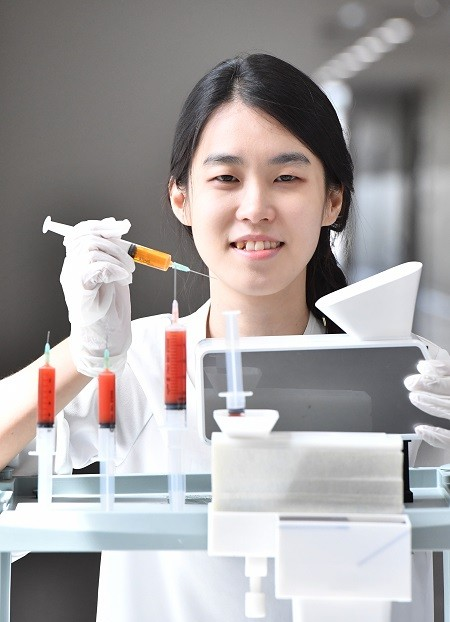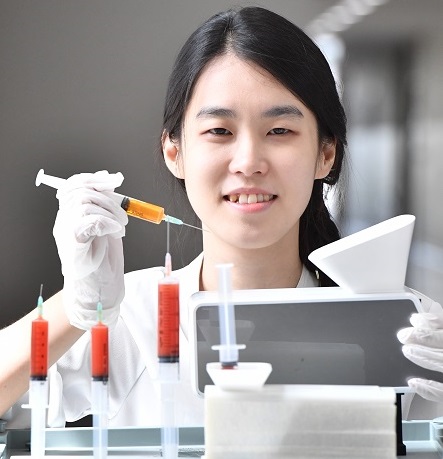- Innovative Engineering for Healthcare Workers October 25, 2018
-
The story of MUNE CEO Yoo-hwa Kim and the safe syringe disposal device
 Yoo-hwa Kim, CEO of MUNE
Yoo-hwa Kim, CEO of MUNEMore than 16 billion syringes are used around the world every year. Every year there are over two million needle-stick injuries worldwide, and 1.7 million people get infected with hepatitis B due to unsafe syringe injection. Yonsei University alumna Yoo-hwa Kim (entering class of ’12, Interior Architecture & Built Environment) is CEO and co-founder of MUNE, a start-up that develops a safe syringe disposal device for healthcare providers.
Q. Briefly introduce yourself.
A. My name is Yoo-hwa Kim, and I am CEO of MUNE Corporation. I currently work with COO Kwang-bin Oh, CTO Nam-hyung Kim, as well as Jae-hak Jeong and Ji-yoon Lee. As a start-up, we aspire to develop products that guarantee work efficiency and safety for healthcare workers. In particular, nurses are most exposed to the danger of various diseases but there no accommodative products for their work environment. In response to this issue, MUNE is developing an automatic syringe separation device that can create a safer hospital environment and address various infection risks.
Q. How did MUNE’s story begin?
A. We first met in an “X-Design” engineering class. I was intrigued because I was already thinking of launching a start-up and the design aspect of the curriculum was inspiring. The concept of the class was very similar to renowned Stanford d.school – to design products that resonate with the user’s situation rather than creating a sellable product after identifying the user’s needs. During class, I worked in groups with students from different majors, such as mechanical engineering, design, and business administration.
One of the class projects was to create a product and each group was funded 2 million KRW (about 1,800 USD). Our group worked even harder, as we had the chance to win an additional 2 million KRW if selected for the SK Young Generation Jump Program. In the end, our team got selected for the program and I received an A+ in class. I achieved 120% of my goals (laughs).
Q. Among the many markets and professions, how did you end up targeting healthcare providers and - more specifically - nurses and syringes?
A. While brainstorming for our product, our group tried to identify the most stressful professions; we discussed that nurses are one of the most stressed workers among medical staff. I knew many people in the nursing field, so I interviewed them and listened to their stories. At that time, the issue of syringe re-usage had been a top topic in the media and I asked nurses about the situation. "Do I look like a nurse who reuses syringes?" one nurse had angrily replied, stressing that most nurses in Korea never reuse syringes.
But the real problem with syringes turned out to be how often nurses were getting pricked by the needles. More than 80% of healthcare providers have experienced needle-stick injuries. Listening to these stories, I thought, “If we could create a product that deals with this problem, we can prevent nurses from infection as well as eliminate syringe re-usage.”
Many nurses contract hepatitis B and hepatitis C after accidentally poking themselves with a needle. According to studies, 37.6% of hepatitis B and 39% of hepatitis C in healthcare workers around the world are due to needle-stick injuries (Source: WHO, 2003). South Korea has low rates, but numbers are quite high in several central and southeast Asian countries. And it is very easy for nurses to get infected. One nurse had injured her hand from a needle but was too busy treating patients to notice. Much to her dismay, she discovered the injury later on her way home – not even knowing when and where it had happened.
Q. Explain MUNE’s automatic separating device.
There are existing devices that separate needles. The methods range from using a basic mold to remove the needle to grinding up the syringe. However, these methods are still inconvenient for the user. The first method still requires the user to remove the needle out of the mold painstakingly by hand. Also, when grinding the needle, the user must wait until the entire needle is broken up. It is a long process and the vibrations are harmful to the wrist.
Our products are installed on bins and separates and disposes of needles in a one-stop process. When a syringe is inserted into the device, the built-in knife cuts its neck part, preventing re-usage and also helping to separate hard-to-break syringe models. Our current product activates with the press of a button, but we are developing a new infrared sensor technology which will allow healthcare workers to simply insert the syringe and leave, giving them time to perform other duties.
Q. How does MUNE operate?
At first, we collaborated with Severance Hospital of the Yonsei University Health System and closely observed the daily routine of nurses. I also discussed products and accumulated stories from nurses at the Nursing Policy Research Institute of the Yonsei University College of Nursing. We continue receiving feedback from nurses. Through a one-month product trial period at Seoul Medical Center, we are receiving comments from the medical staff.
MUNE’s investors include Blue Point Partners and Digital Healthcare Partners. We were also selected as one of the top 100 companies at a start-up contest held in San Francisco. We were also selected by the Korean International Cooperation Agency (KOICA) for a 300 million KRW (about 260,000 USD) project. Through our products, we reduce the risk of medical staff to contract blood-transmitted diseases such as hepatitis A and B.
We have also performed product trial tests at a hospital in Vietnam and plan to visit again soon. MUNE is developing products that are suitable for regions in Vietnam that do not use electric trash cans. We discovered that healthcare providers in these regions separate the syringes and throw them away in PET bottles. This gave us the idea to create a product that can be effective in an environment that does not use electric recycle bins. So we are in the process of developing a shape suitable for PET bottles. It is a difficult process, as this model is not standardized, but we are trying our best.
Q. What are your future goals?
A. We will continue to develop products for healthcare workers - we will pursue two directions. One is to continue creating products that can safely treat medical waste, and the other is to increase the efficiency and convenience for medical staff. For example, smart medical carts. We do not want to change everything in the hospital, but we want to make life easier beginning with the “little things.”
Our long-term goal is to advance the quality of healthcare by improving the welfare of healthcare providers with new and original inventions, which in turn derives a better patient experience and thus creates a safe and healthy hospital environment for all.
Q. Any words of advice to younger Yonseians who dream of starting a business?
A. I wish them all success, but I would also advise them to begin after forming their team. Many people make good plans, but sometimes they cannot make those plans a reality. If you cannot execute your ideas, it is impossible to progress. You need human capital to do it right - either organize a strong team or recruit talented people in order to turn your dreams into reality.
show mobile menu
mobile menu




